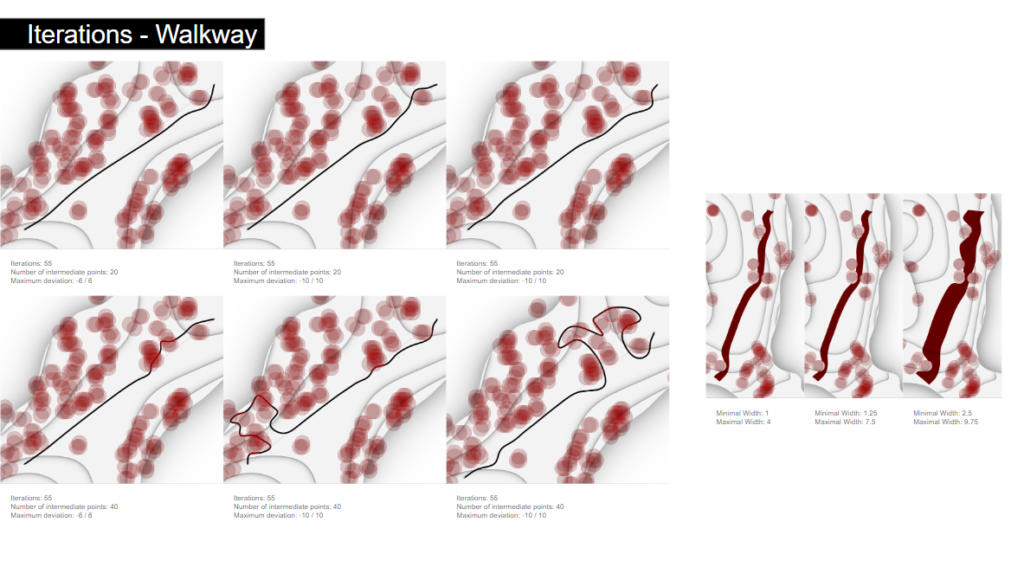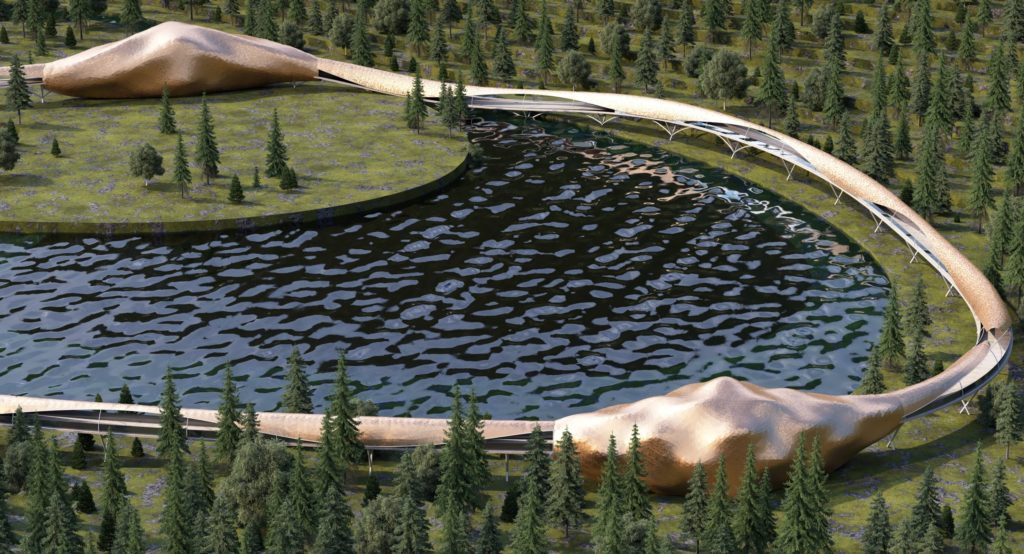Introduction
Inspired from the native four-lined snake that is considered to be nearly extinct, the project’s form draws inspiration from the physiological, biological and behavioral characteristics of the snake through different stages of its life. The same will define the museum’s form and the visitor’s journey.
Project Description
Through analyzing the locomotion of the snake in specific phases of its life, the overall form of the project is shaped and generated.
The proposal is defined by a continuous path that reacts to the site by adapting to the different terrain and the existing trees. The visitors’ journey starts through a bridge that is winding and wrapping across the topography surrounding the central lake. throughout this journey, the visitors have direct visual contact with the two main buildings creating a sense of anticipation.
The first building merges out of the bridge creating a gathering space where visitors learn about the species and its early stages of life. Afterward, the visitor’s continue on the path where the bridge starts to ramp up on height replicating the snakes ability on climbing and at the same time giving the visitors’ a unique vantage point of the overall surrounding.
Finally, the bridge starts to decent into the Main building which seamlessly integrates with the exiting part of the bridge. Inside the main building, there will be a dedicated gallery on the species mating behavior as well as its dormant phases where it enters into hibernation.
A customized paneling system was selected to mimic the snakes unique skin while creating a statement within the context highlighting the importance of the species and further capturing the visitors’ attention.

Workflow Gangway
The design process of the walkway was driven by the intention to ensure a harmonious integration into the natural landscape, without the need for excessive tree felling. The following steps were taken:
Initially, we recorded the exact locations of the trees. We focused on groups of trees that were closely clustered within a certain radius. In contrast, solitary trees were considered potential candidates for removal. Safety zones were established around the selected groups of trees.
With defined starting and ending points for the path, we first looked for a direct connection line that, considering the safety zones, would cause the fewest collisions with the trees. In an iterative process, we checked whether the connection line went through safety zones. If there were intersections, the line was randomly adjusted and re-evaluated. This process resulted in a path layout that required fewer tree removals and already exhibited a natural winding shape.
The winding line was then expanded to form the actual path. The expansion was controlled by setting minimum and maximum widths, ensuring that the minimum width was achieved even if it encroached on a tree’s safety zone.
The outer boundaries of the walkway were aligned with the topography of the terrain. This ensured that the bridge always maintained a predefined distance from the ground.
Finally, we designed the individual elements of the bridge, including the roof, supporting structure, railings, and supports. These elements could also be partially controlled parametrically. For example, it is possible to alter the shading elements of the gangway.
Workflow Buildings
First, we determined at which section of the path the boundaries of the building should begin. This decision was of central importance as it marked the transition between the natural exterior and the structured interior of the buildings. A key element was the integration of the gangway into the building design. This included the careful planning of the intersection points, taking into account a clearance profile to ensure a seamless and unobstructed connection between the gangway and the building.
The final step was the application of the shed roof tiles. These tiles reflected the theme of snake skin and enhanced the visual connection to the overall theme of the project. Their installation was both an artistic and technical process, aimed at creating a unique texture that blends into the natural environment.
Iterations
After completing the base script, we conducted several iterations to test how well and adaptively the script worked. During the path generation, it turned out that if the parameters were chosen with too much freedom, such as a too large distance between the fixed points and an excessively high permitted displacement distance, the paths became unnecessarily complicated and sometimes got tangled up in individual groups of trees. With more constrained parameters, the results appeared significantly more natural.
Changes to the parameters of the buildings were also possible. They responded to adjustments in the path and allowed for further modifications to their external shape, such as building dimensions, the number of twists, and waves in the surface.


Visualisation




